Zhenglong Sun
Robotics and Intelligent Manufacturing & School of Science and Engineering, The Chinese University of Hong Kong, Shenzhen, China, Shenzhen Institute of Artificial Intelligence and Robotics for Society, China
GenTe: Generative Real-world Terrains for General Legged Robot Locomotion Control
Apr 14, 2025Abstract:Developing bipedal robots capable of traversing diverse real-world terrains presents a fundamental robotics challenge, as existing methods using predefined height maps and static environments fail to address the complexity of unstructured landscapes. To bridge this gap, we propose GenTe, a framework for generating physically realistic and adaptable terrains to train generalizable locomotion policies. GenTe constructs an atomic terrain library that includes both geometric and physical terrains, enabling curriculum training for reinforcement learning-based locomotion policies. By leveraging function-calling techniques and reasoning capabilities of Vision-Language Models (VLMs), GenTe generates complex, contextually relevant terrains from textual and graphical inputs. The framework introduces realistic force modeling for terrain interactions, capturing effects such as soil sinkage and hydrodynamic resistance. To the best of our knowledge, GenTe is the first framework that systemically generates simulation environments for legged robot locomotion control. Additionally, we introduce a benchmark of 100 generated terrains. Experiments demonstrate improved generalization and robustness in bipedal robot locomotion.
Hybrid NeRF-Stereo Vision: Pioneering Depth Estimation and 3D Reconstruction in Endoscopy
Oct 10, 2024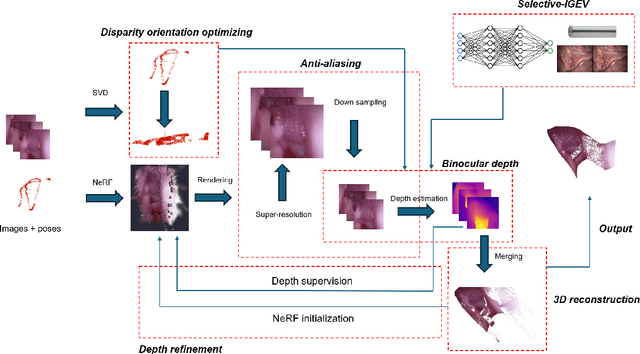
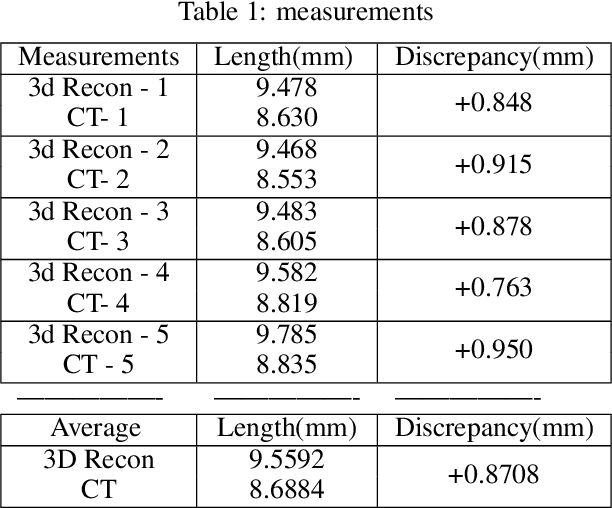
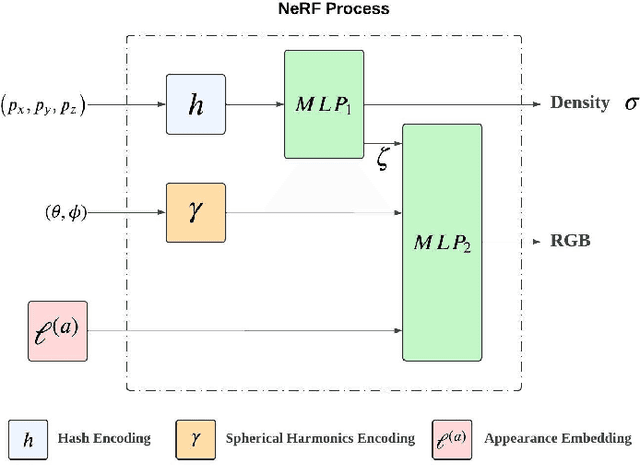
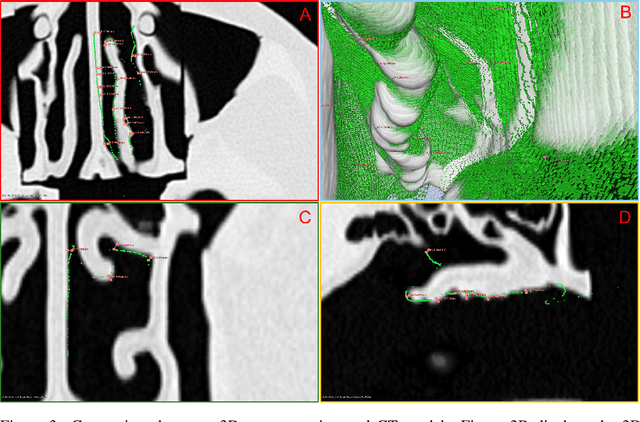
Abstract:The 3D reconstruction of the surgical field in minimally invasive endoscopic surgery has posed a formidable challenge when using conventional monocular endoscopes. Existing 3D reconstruction methodologies are frequently encumbered by suboptimal accuracy and limited generalization capabilities. In this study, we introduce an innovative pipeline using Neural Radiance Fields (NeRF) for 3D reconstruction. Our approach utilizes a preliminary NeRF reconstruction that yields a coarse model, then creates a binocular scene within the reconstructed environment, which derives an initial depth map via stereo vision. This initial depth map serves as depth supervision for subsequent NeRF iterations, progressively refining the 3D reconstruction with enhanced accuracy. The binocular depth is iteratively recalculated, with the refinement process continuing until the depth map converges, and exhibits negligible variations. Through this recursive process, high-fidelity depth maps are generated from monocular endoscopic video of a realistic cranial phantom. By repeated measures of the final 3D reconstruction compared to X-ray computed tomography, all differences of relevant clinical distances result in sub-millimeter accuracy.
DataCook: Crafting Anti-Adversarial Examples for Healthcare Data Copyright Protection
Mar 26, 2024



Abstract:In the realm of healthcare, the challenges of copyright protection and unauthorized third-party misuse are increasingly significant. Traditional methods for data copyright protection are applied prior to data distribution, implying that models trained on these data become uncontrollable. This paper introduces a novel approach, named DataCook, designed to safeguard the copyright of healthcare data during the deployment phase. DataCook operates by "cooking" the raw data before distribution, enabling the development of models that perform normally on this processed data. However, during the deployment phase, the original test data must be also "cooked" through DataCook to ensure normal model performance. This process grants copyright holders control over authorization during the deployment phase. The mechanism behind DataCook is by crafting anti-adversarial examples (AntiAdv), which are designed to enhance model confidence, as opposed to standard adversarial examples (Adv) that aim to confuse models. Similar to Adv, AntiAdv introduces imperceptible perturbations, ensuring that the data processed by DataCook remains easily understandable. We conducted extensive experiments on MedMNIST datasets, encompassing both 2D/3D data and the high-resolution variants. The outcomes indicate that DataCook effectively meets its objectives, preventing models trained on AntiAdv from analyzing unauthorized data effectively, without compromising the validity and accuracy of the data in legitimate scenarios. Code and data are available at https://github.com/MedMNIST/DataCook.
SD-DiT: Unleashing the Power of Self-supervised Discrimination in Diffusion Transformer
Mar 25, 2024Abstract:Diffusion Transformer (DiT) has emerged as the new trend of generative diffusion models on image generation. In view of extremely slow convergence in typical DiT, recent breakthroughs have been driven by mask strategy that significantly improves the training efficiency of DiT with additional intra-image contextual learning. Despite this progress, mask strategy still suffers from two inherent limitations: (a) training-inference discrepancy and (b) fuzzy relations between mask reconstruction & generative diffusion process, resulting in sub-optimal training of DiT. In this work, we address these limitations by novelly unleashing the self-supervised discrimination knowledge to boost DiT training. Technically, we frame our DiT in a teacher-student manner. The teacher-student discriminative pairs are built on the diffusion noises along the same Probability Flow Ordinary Differential Equation (PF-ODE). Instead of applying mask reconstruction loss over both DiT encoder and decoder, we decouple DiT encoder and decoder to separately tackle discriminative and generative objectives. In particular, by encoding discriminative pairs with student and teacher DiT encoders, a new discriminative loss is designed to encourage the inter-image alignment in the self-supervised embedding space. After that, student samples are fed into student DiT decoder to perform the typical generative diffusion task. Extensive experiments are conducted on ImageNet dataset, and our method achieves a competitive balance between training cost and generative capacity.
Prompt-based Learning for Unpaired Image Captioning
May 26, 2022
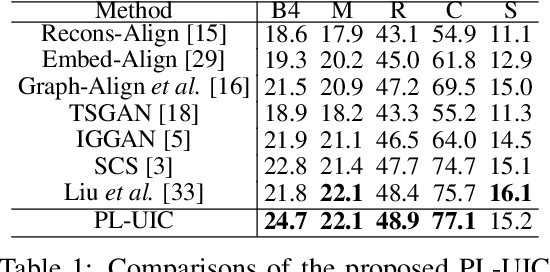
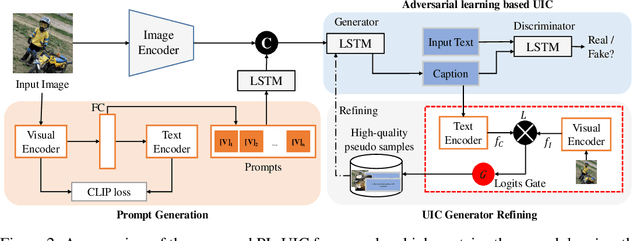
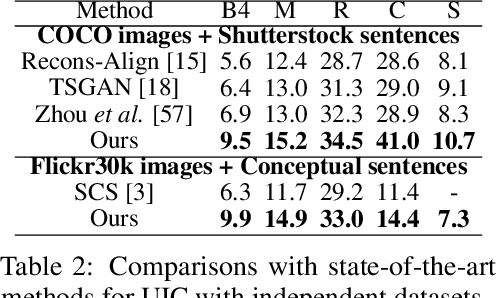
Abstract:Unpaired Image Captioning (UIC) has been developed to learn image descriptions from unaligned vision-language sample pairs. Existing schemes usually adopt the visual concept reward of reinforcement learning to obtain the alignment between visual concepts and images. However, the cross-domain alignment is usually weak that severely constrains the overall performance of these existing schemes. Recent successes of Vision-Language Pre-Trained Models (VL-PTMs) have triggered the development of prompt-based learning from VL-PTMs. We present in this paper a novel scheme based on prompt to train the UIC model, making best use of the powerful generalization ability and abundant vision-language prior knowledge learned under VL-PTMs. We adopt the CLIP model for this research in unpaired image captioning. Specifically, the visual images are taken as input to the prompt generation module, which contains the pre-trained model as well as one feed-forward layer for prompt extraction. Then, the input images and generated prompts are aggregated for unpaired adversarial captioning learning. To further enhance the potential performance of the captioning, we designed a high-quality pseudo caption filter guided by the CLIP logits to measure correlations between predicted captions and the corresponding images. This allows us to improve the captioning model in a supervised learning manner. Extensive experiments on the COCO and Flickr30K datasets have been carried out to validate the superiority of the proposed model. We have achieved the state-of-the-art performance on the COCO dataset, which outperforms the best UIC model by 1.9% on the BLEU-4 metric. We expect that the proposed prompt-based UIC model will inspire a new line of research for the VL-PTMs based captioning.
Unpaired Image Captioning by Image-level Weakly-Supervised Visual Concept Recognition
Mar 07, 2022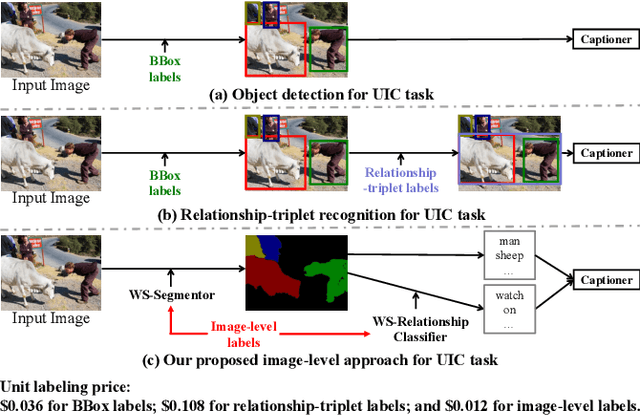
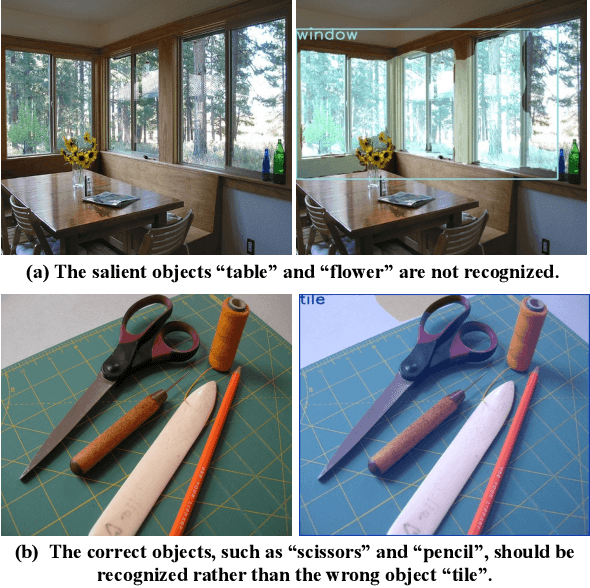
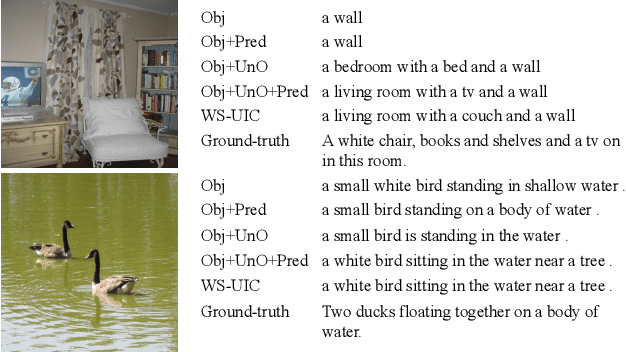
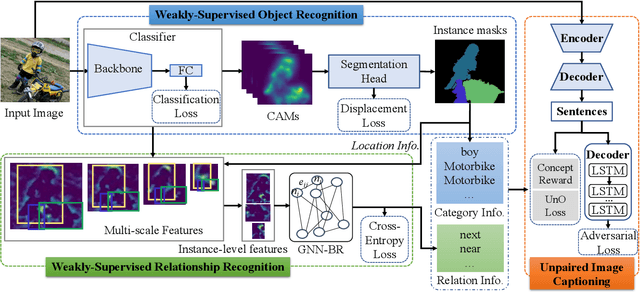
Abstract:The goal of unpaired image captioning (UIC) is to describe images without using image-caption pairs in the training phase. Although challenging, we except the task can be accomplished by leveraging a training set of images aligned with visual concepts. Most existing studies use off-the-shelf algorithms to obtain the visual concepts because the Bounding Box (BBox) labels or relationship-triplet labels used for the training are expensive to acquire. In order to resolve the problem in expensive annotations, we propose a novel approach to achieve cost-effective UIC. Specifically, we adopt image-level labels for the optimization of the UIC model in a weakly-supervised manner. For each image, we assume that only the image-level labels are available without specific locations and numbers. The image-level labels are utilized to train a weakly-supervised object recognition model to extract object information (e.g., instance) in an image, and the extracted instances are adopted to infer the relationships among different objects based on an enhanced graph neural network (GNN). The proposed approach achieves comparable or even better performance compared with previous methods without the expensive cost of annotations. Furthermore, we design an unrecognized object (UnO) loss combined with a visual concept reward to improve the alignment of the inferred object and relationship information with the images. It can effectively alleviate the issue encountered by existing UIC models about generating sentences with nonexistent objects. To the best of our knowledge, this is the first attempt to solve the problem of Weakly-Supervised visual concept recognition for UIC (WS-UIC) based only on image-level labels. Extensive experiments have been carried out to demonstrate that the proposed WS-UIC model achieves inspiring results on the COCO dataset while significantly reducing the cost of labeling.
Unsupervised Monocular Depth Perception: Focusing on Moving Objects
Aug 30, 2021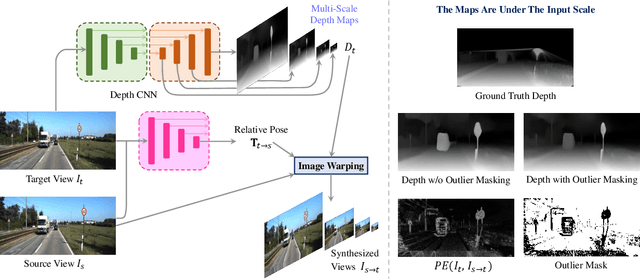
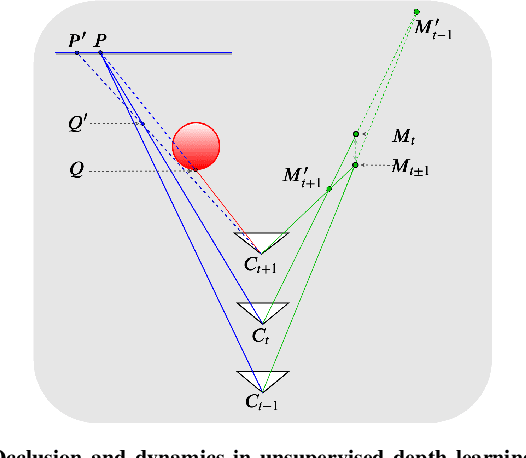
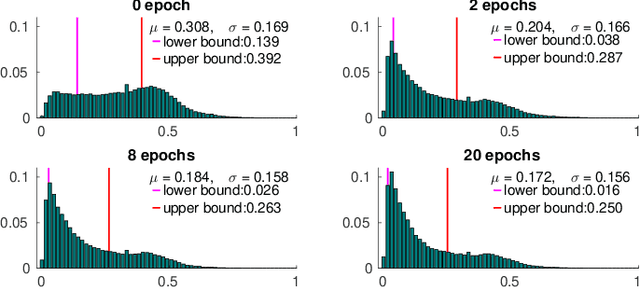
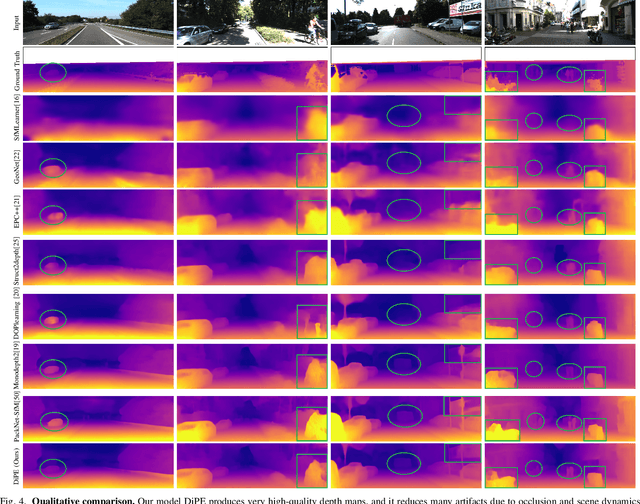
Abstract:As a flexible passive 3D sensing means, unsupervised learning of depth from monocular videos is becoming an important research topic. It utilizes the photometric errors between the target view and the synthesized views from its adjacent source views as the loss instead of the difference from the ground truth. Occlusion and scene dynamics in real-world scenes still adversely affect the learning, despite significant progress made recently. In this paper, we show that deliberately manipulating photometric errors can efficiently deal with these difficulties better. We first propose an outlier masking technique that considers the occluded or dynamic pixels as statistical outliers in the photometric error map. With the outlier masking, the network learns the depth of objects that move in the opposite direction to the camera more accurately. To the best of our knowledge, such cases have not been seriously considered in the previous works, even though they pose a high risk in applications like autonomous driving. We also propose an efficient weighted multi-scale scheme to reduce the artifacts in the predicted depth maps. Extensive experiments on the KITTI dataset and additional experiments on the Cityscapes dataset have verified the proposed approach's effectiveness on depth or ego-motion estimation. Furthermore, for the first time, we evaluate the predicted depth on the regions of dynamic objects and static background separately for both supervised and unsupervised methods. The evaluation further verifies the effectiveness of our proposed technical approach and provides some interesting observations that might inspire future research in this direction.
Improving Contrastive Learning by Visualizing Feature Transformation
Aug 06, 2021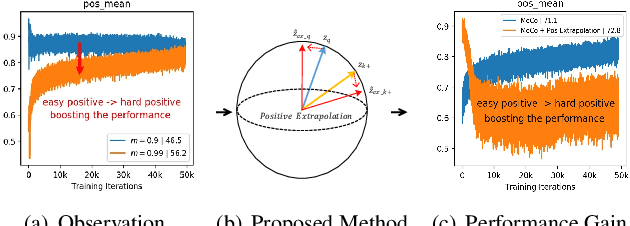

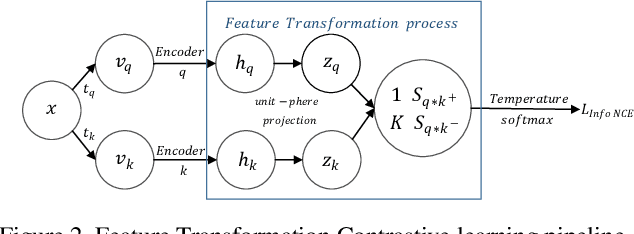

Abstract:Contrastive learning, which aims at minimizing the distance between positive pairs while maximizing that of negative ones, has been widely and successfully applied in unsupervised feature learning, where the design of positive and negative (pos/neg) pairs is one of its keys. In this paper, we attempt to devise a feature-level data manipulation, differing from data augmentation, to enhance the generic contrastive self-supervised learning. To this end, we first design a visualization scheme for pos/neg score (Pos/neg score indicates cosine similarity of pos/neg pair.) distribution, which enables us to analyze, interpret and understand the learning process. To our knowledge, this is the first attempt of its kind. More importantly, leveraging this tool, we gain some significant observations, which inspire our novel Feature Transformation proposals including the extrapolation of positives. This operation creates harder positives to boost the learning because hard positives enable the model to be more view-invariant. Besides, we propose the interpolation among negatives, which provides diversified negatives and makes the model more discriminative. It is the first attempt to deal with both challenges simultaneously. Experiment results show that our proposed Feature Transformation can improve at least 6.0% accuracy on ImageNet-100 over MoCo baseline, and about 2.0% accuracy on ImageNet-1K over the MoCoV2 baseline. Transferring to the downstream tasks successfully demonstrate our model is less task-bias. Visualization tools and codes https://github.com/DTennant/CL-Visualizing-Feature-Transformation .
BORM: Bayesian Object Relation Model for Indoor Scene Recognition
Aug 01, 2021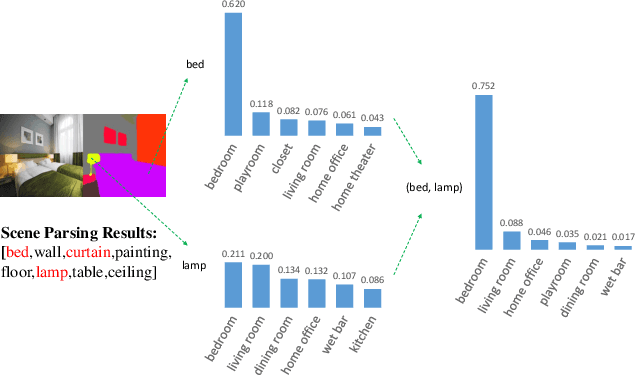
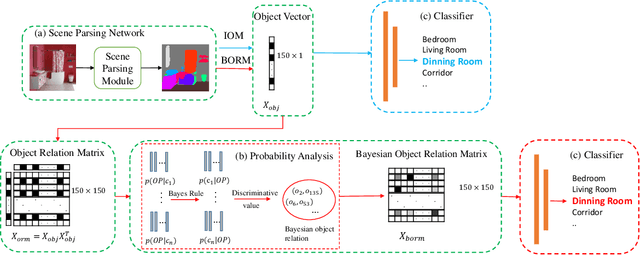
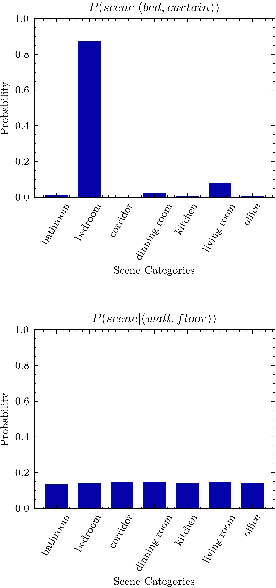
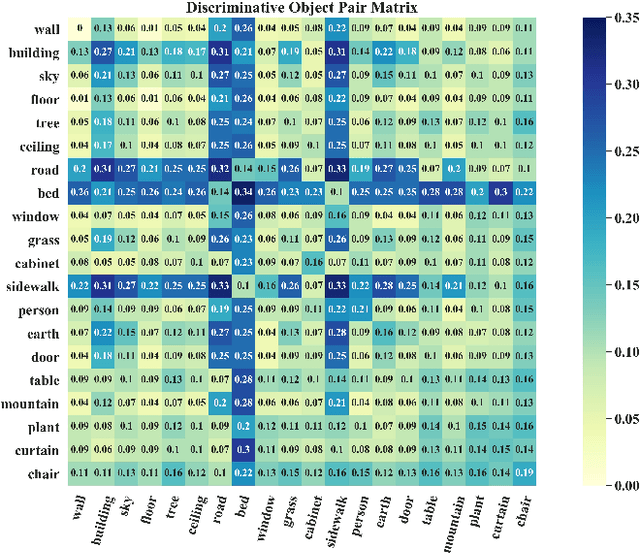
Abstract:Scene recognition is a fundamental task in robotic perception. For human beings, scene recognition is reasonable because they have abundant object knowledge of the real world. The idea of transferring prior object knowledge from humans to scene recognition is significant but still less exploited. In this paper, we propose to utilize meaningful object representations for indoor scene representation. First, we utilize an improved object model (IOM) as a baseline that enriches the object knowledge by introducing a scene parsing algorithm pretrained on the ADE20K dataset with rich object categories related to the indoor scene. To analyze the object co-occurrences and pairwise object relations, we formulate the IOM from a Bayesian perspective as the Bayesian object relation model (BORM). Meanwhile, we incorporate the proposed BORM with the PlacesCNN model as the combined Bayesian object relation model (CBORM) for scene recognition and significantly outperforms the state-of-the-art methods on the reduced Places365 dataset, and SUN RGB-D dataset without retraining, showing the excellent generalization ability of the proposed method. Code can be found at https://github.com/hszhoushen/borm.
* 8 pages, 5 figures, conference, Accepted by IROS2021
Learning a Skill-sequence-dependent Policy for Long-horizon Manipulation Tasks
May 12, 2021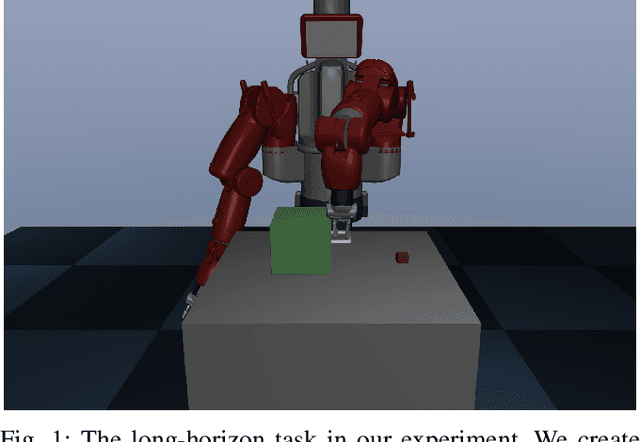
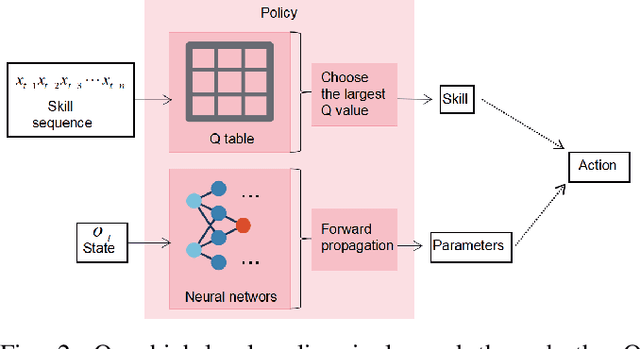
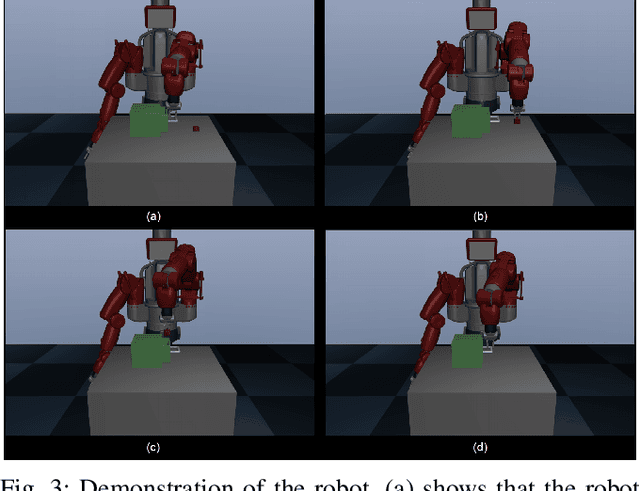
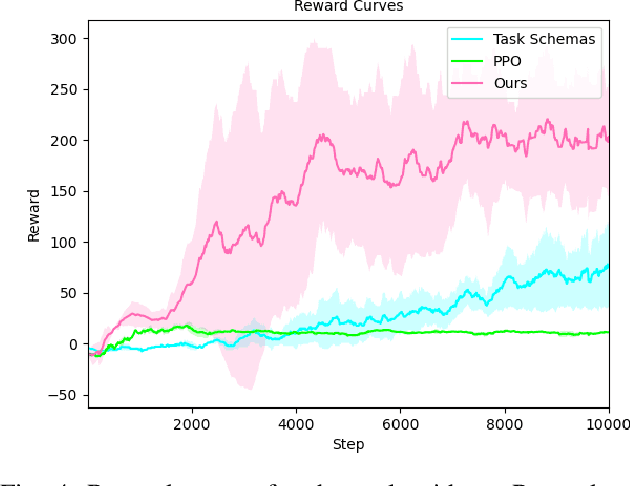
Abstract:In recent years, the robotics community has made substantial progress in robotic manipulation using deep reinforcement learning (RL). Effectively learning of long-horizon tasks remains a challenging topic. Typical RL-based methods approximate long-horizon tasks as Markov decision processes and only consider current observation (images or other sensor information) as input state. However, such approximation ignores the fact that skill-sequence also plays a crucial role in long-horizon tasks. In this paper, we take both the observation and skill sequences into account and propose a skill-sequence-dependent hierarchical policy for solving a typical long-horizon task. The proposed policy consists of a high-level skill policy (utilizing skill sequences) and a low-level parameter policy (responding to observation) with corresponding training methods, which makes the learning much more sample-efficient. Experiments in simulation demonstrate that our approach successfully solves a long-horizon task and is significantly faster than Proximal Policy Optimization (PPO) and the task schema methods.
 Add to Chrome
Add to Chrome Add to Firefox
Add to Firefox Add to Edge
Add to Edge